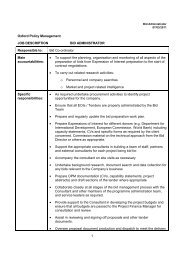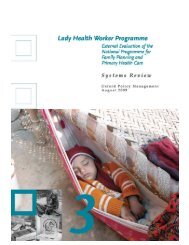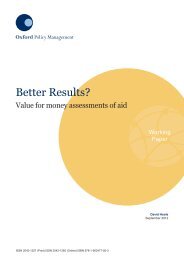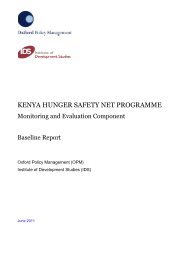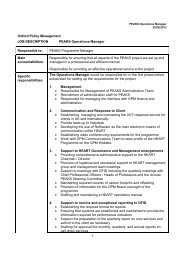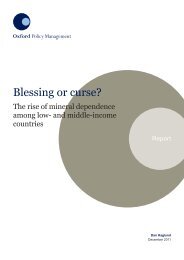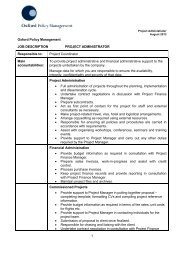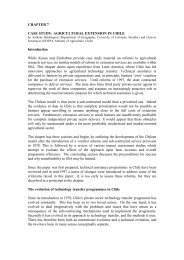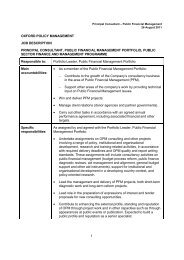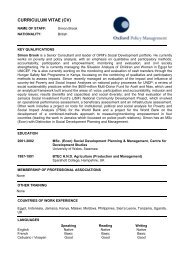LHW Punjab and ICT Report - Oxford Policy Management
LHW Punjab and ICT Report - Oxford Policy Management
LHW Punjab and ICT Report - Oxford Policy Management
You also want an ePaper? Increase the reach of your titles
YUMPU automatically turns print PDFs into web optimized ePapers that Google loves.
LADY HEALTH WORKER EVALUATION – PUNJAB AND <strong>ICT</strong> SURVEY REPORTPERFORMANCE OF LADY HEALTH WORKERS IN SERVICE DELIVERYWe have developed a performance measure of <strong>LHW</strong> service delivery using a selection of tenpreventive services. 13 These cover <strong>LHW</strong> activities in, hygiene, health education, vaccinationpromotion, family planning, pregnancy <strong>and</strong> birth, child nutrition <strong>and</strong> growth monitoring.Using our measure of performance we find major differences in the levels of service deliveryamongst <strong>LHW</strong>s. The top 25 percent - the High Performers provide significantly moreservices than the bottom 25 percent- the Poor Performers. In between we have the GoodPerformers <strong>and</strong> those who are Below Average.Figure 3-1 Lady Health Worker Provision of Service by Performance Category% target population provided services100908070605040302010017Poor Performers35Below AveragePerformers4868Good Performers High PerformersOn our performance measure the Poor Performers are on average only providingservices to seventeen percent of their eligible clients as compared to the High Performers whoprovide on average services to sixty-eight percent (Figure 3-1). It is easy to distinguish PoorPerformers because they fail to deliver across the whole range of services whereas HighPerformers cover at least sixty percent of clients 14 - <strong>and</strong> often well above this - for allservices, except growth monitoring. 15 High Performing <strong>LHW</strong>s are also working longer hours.In the week preceding the survey they had worked over twenty-two hours compared toseventeen for poor performers.In <strong>Punjab</strong> <strong>and</strong> <strong>ICT</strong> twenty-three percent of <strong>LHW</strong>s are in the high performing category<strong>and</strong> twenty-two percent are Poor Performers (Figure 3-2). The challenge for the <strong>LHW</strong>Pmanagers is to improve the performance of the fifty- percent of Poor <strong>and</strong> Below AveragePerformers.13 See Appendix 4 <strong>and</strong> the Quantitative Survey <strong>Report</strong> for a description of the performance measure of <strong>LHW</strong> servicedelivery.14 See Appendix 5 for more information on different levels of performance amongst Lady Health Workers.15 The low level of growth monitoring even in the relatively high performing <strong>LHW</strong>s suggests that there are specificproblems that need to be addressed if the Programme considers it important to offer this service.12



